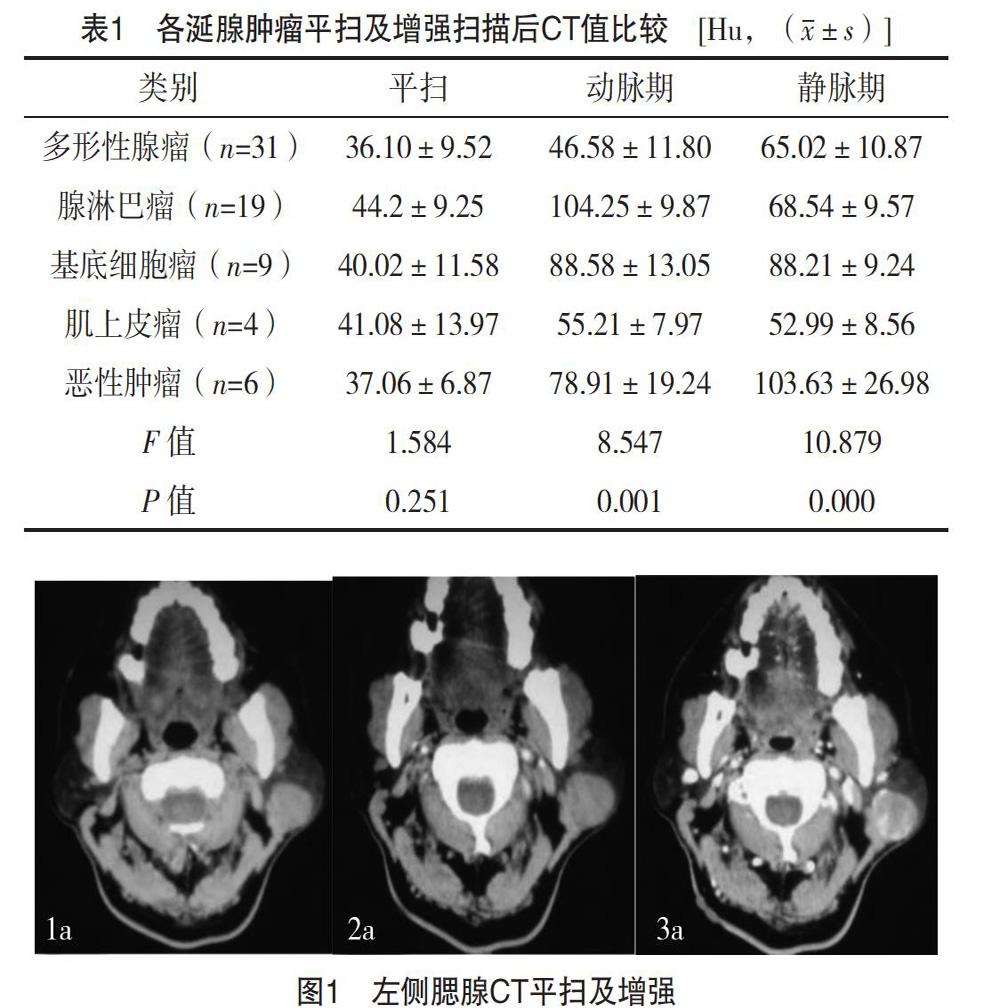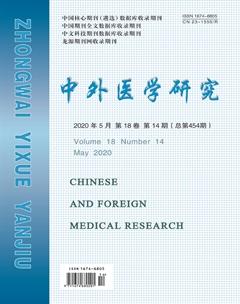64排螺旋CT常规及增强检查在涎腺占位性病变的诊断和鉴别诊断中的临床意义
陈巍岚 马兴灿 郭作梁

【摘要】 目的:探讨64排螺旋CT常规及增强检查在涎腺占位性病变的诊断和鉴别诊断中的临床意义。方法:选取2015年8月-2019年8月笔者所在医院收治的涎腺肿瘤患者69例。对所有患者行64排螺旋CT常规及增强检查,对比不同组织的影像学参数。结果:平扫可见涎腺肿瘤病灶均为等密度或低密度影,不同肿瘤间的CT值差异无统计学意义(P>0.05)。进行双期增强扫描可见,多形性腺瘤动脉期无强化或轻度强化,静脉期强化程度高于动脉期;腺淋巴瘤呈“快进快出”的强化特征;基底细胞瘤动脉期和静脉期均有显著强化;肌上皮瘤动、静脉期均有轻度强化;黏液表皮样癌、腮腺细胞癌和涎腺导管癌等恶性肿瘤则为延迟显著渐进强化特点。在动脉期,腺淋巴瘤的CT值明显高于其他肿瘤,在静脉期,则恶性肿瘤的CT值最高,差异均有统计学意义(P<0.05)。结论:在64排螺旋CT的基础上增强扫描,不同病理分型肿瘤具有各自显著特征,该技术还能通过机体血流动力学相关指标对涎腺肿瘤的良、恶性加以鉴别诊断,具有一定临床价值。
【关键词】 64排螺旋CT 增强扫描 涎腺 肿瘤
[Abstract] Objective: To explore the clinical significance of 64 slice spiral CT routine and enhanced scan in the diagnosis and differential diagnosis of salivary gland space occupying lesions. Method: From August 2015 to August 2019, 69 patients with salivary gland tumor were selected. All patients were examined with 64 slice spiral CT routine and enhanced scan, and the imaging parameters of different tissues were compared. Result: On plain scan, the lesions of salivary gland tumors were isodense or hypodense, there was no significant difference in CT value between different tumors (P>0.05). Double phase contrast-enhanced scan showed that pleomorphic adenoma had no or slight enhancement in arterial phase, and the enhancement degree in venous phase was higher than that in arterial phase; adenolymphoma had the characteristics of “fast in and fast out”; basal cell tumor had significant enhancement in arterial phase and venous phase; myoepithelioma had slight enhancement in arterial and venous phase; mucoepidermoid carcinoma, parotid cell carcinoma, salivary duct carcinoma and other malignant tumors were characterized by delayed and progressive enhancement. In arterial phase, the CT value of adenolymphoma was significantly higher than that of other tumors. In venous phase, the CT value of malignant tumors was the highest, the differences were statistically significant (P<0.05). Conclusion: On the basis of 64 slice spiral CT, enhanced scan can show their own significant characteristics of different pathological types of tumors. This technology can also differentiate the benign and malignant salivary gland tumors through the related indexes of hemodynamics, which has a certain clinical value.
涎腺包括腮腺、頜下腺、舌下腺三对大涎腺及散布在口腔黏膜下的许多小涎腺[1]。肿瘤是涎腺组织中最常见的疾病,其中绝大多数是上皮性肿瘤,由于涎腺上皮性肿瘤的病理类型复杂、形态多变,不同类型的肿瘤在临床表现、影像学表现、治疗和预后等方面均不相同[2]。常规的影像学检查仅可确定病灶的部位、大小、范围,但在鉴别涎腺肿瘤良、恶性方面易受到检查者主观性因素的影响,准确率较低。故探寻一种行之有效的影像学诊断方法具有重要意义[3]。本研究选取2015年8月-2019年8月笔者所在医院收治的涎腺肿瘤患者69例,以探讨64排螺旋CT常规及增强扫描在涎腺占位性病变的诊断和鉴别诊断的临床意义,现报道如下。
1 资料与方法
1.1 一般资料
选取2015年8月-2019年8月笔者所在医院收治的涎腺肿瘤患者69例,其中男35例,女34例。年龄19~72岁,平均(43.8±5.3)岁。纳入标准:(1)经相关诊断明确符合涎腺肿瘤的标准;(2)未接受肿瘤放化疗治疗;(3)肿瘤直径≥10 mm。排除标准:(1)对造影剂过敏;(2)合并重要脏器器质性病变;(3)合并精神类疾病无法配合完成治疗。
1.2 方法
64排螺旋CT检查使用SOMATOM Definition AS+及AW 4.2工作站进行,具体参数为管电压120 kV,管电流250 mA,DFOV 25 cm,准直32×0.625 mm,矩阵512×512,球管旋转周期0.4 s。患者取仰卧位,双管高压注射器将碘海醇对比剂(300 mg/ml)以4 ml/s注射,扫描延迟5~15 s,总时间50 s。所有患者接受平扫之后,再进行CT双期增强扫描,扫描前以3 ml/s高压注射造影剂85 ml,扫描时相动脉期延迟25 s,静脉期延迟60 s。
所有图像结果均由笔者所在科2名经验丰富的影像医师共同完成。
1.3 统计学处理
使用SPSS 19.0软件包对本研究数据进行统计学分析。验证数据正态分布性后,计量资料使用(x±s)表示,多组间进行单因素方差分析。计数资料使用率(%)表示,进行字2检验,以α=0.05为检验标准。P<0.05为差异有统计学意义。
2 结果
69例患者经病理学检查,共检查出涎腺占位性病灶72个,其中多形性腺瘤31例(31个病灶),腺淋巴瘤19例(22个病灶),基底细胞瘤9例(9个病灶),肌上皮瘤4例(4个病灶),黏液表皮样癌3例(3个病灶),腮腺细胞癌1例(1个病灶),涎腺导管癌2例(2个病灶)。平扫可见上述病灶均为等密度或较低密度影,但不同病理分型肿瘤间的CT值差异无统计学意义(P>0.05),见表1。
进行双期增强扫描可见,多形性腺瘤动脉期无强化或仅有轻度强化,静脉期强化程度高于动脉期;腺淋巴瘤呈“快进快出”的强化特征;基底细胞瘤动脉期和静脉期均有显著强化;肌上皮瘤动、静脉期均有轻度强化;黏液表皮样癌、腮腺细胞癌和涎腺导管癌等恶性肿瘤则为延迟显著渐进强化特点。在动脉期,腺淋巴瘤的CT值明显高于其他肿瘤,在静脉期,则恶性肿瘤的CT值最高,差异均有统计学意义(P<0.05),见表1。影像学检查见图1,男,42岁,多形性腺瘤患者。
3 讨论
正常涎腺组织因其丰富的脂肪组织含量,在影像学CT平扫检查时图像密度与周围的肌肉组织能形成较清晰的天然对比,因此,绝大部分涎腺肿瘤能通过CT平扫进行清晰显示,有学者研究认为,平扫检查对涎腺肿瘤的定位率高达100%[4]。但对于不同病理分型的涎腺肿瘤,其在CT平扫时均变现为等密度或低密度影,难以通过CT值差异对其进行辨别诊断。尽管目前良性涎腺肿瘤多位于浅叶,边界规整清晰,恶性涎腺肿瘤多膨胀于深叶,并向周围组织侵犯这一理论已得到广泛认可[5],但统计学分析却显示,良、恶性涎腺肿瘤在形态和边界上的差异并无意义[6]。故使用CT平扫对涎腺肿瘤进行定性、定量诊断会有较大的局限性[7]。在本研究中,选取笔者所在医院收治的69例涎腺占位性病变患者进行回顾性分析,发现患者接受CT平扫和双期增强扫描后,不同病理分型涎腺肿瘤的强化方式与强化程度不一,能够为该类患者的定性诊断提供理论依据。
笔者将本研究中不同类型涎腺肿瘤接受CT平扫和双期增强扫描后的影像学特诊表述如下:(1)多形性腺瘤,该类肿瘤又被称为混合瘤,好发于腮腺浅叶,肿瘤直径以3 cm以下居多,CT平扫时病灶为等密度或低密度影,并可能出现囊变,增强扫描可见动脉期病灶无强化或仅轻度强化,静脉期病灶強化程度较动脉期明显,可为轻度或中度强化[8]。(2)腺淋巴瘤,该类肿瘤好发于腮腺浅叶后下极及尾部,笔者推测这与腮腺淋巴结组织的分布有关。病灶以多发性为常见,患者可为单侧性多发或双侧受累。肿瘤直径同样以3 cm以下居多,CT平扫时病灶为等密度影,约1/4出现囊变[9],增强扫描可见动脉期病灶有显著强化,推测这与肿瘤实质中丰富的毛细血管含量及毛细血管扩张密切相关,静脉期病灶则为轻度强化,总体呈“快进快出”的强化特征[10]。(3)基底细胞瘤,病灶常边界清晰,好发于腮腺浅叶,CT平扫呈等密度影,4/5出现较大囊变[11],增强扫描可见病灶在动脉期和静脉期均呈显著强化,这与肿瘤实质内丰富的毛细血管和小静脉有关,总体呈“早期显著持续强化”特征[12]。(4)肌上皮瘤多位于腮腺浅叶,边界清晰,CT平扫示病灶为等密度影,有部分病理出现小囊变,增强扫描示动脉期和静脉期均有轻度强化[13]。(5)恶性肿瘤包括黏液表皮样癌、腮腺细胞癌、涎腺导管癌等,肿瘤大小为2~5 cm,CT平扫病灶密度不均,边界不清晰,有侵犯周围组织或区域淋巴结转移的特点[14],肿瘤实质内有不同程度的坏死或囊变,增强扫描体上为“延迟显著强化持续”的特点[15]。
综上所述,在64排螺旋CT的基础上增强扫描,不同病理分型肿瘤具有各自显著特征,该技术还能通过机体血流动力学相关指标对涎腺肿瘤的良、恶性加以鉴别诊断,局有一定临床价值。
参考文献
[1] Benjamin A F,Colin C E,John R,et al.Effect of rituximab on a salivary gland ultrasound score in primary Sj?grens syndrome: results of the TRACTISS randomised double-blind multicentre substudy[J].Annals of the Rheumatic Diseases,2018,77(3):412-418.
[2] Yue D,Feng W,Ning C,et al.Myoepithelial carcinoma of the salivary gland: pathologic and CT imaging characteristics (report of 10 cases and literature review)[J].Oral Surgery,Oral Medicine,Oral Pathology and Oral Radiology,2017,123(6):e182-e187.
[3] Thomas J Vogl,Moritz H Albrecht,Nour-El-din A Nour-Eldin,et al.
Assessment of salivary gland tumors using MRI and CT: impact of experience on diagnostic accuracy[J].La Radiologia Medica,2017,123(2):1-12.
[4] Cheng-En Hsieh,Nai-Ming Cheng,Wen-Chi Chou,et al.Pretreatment primary tumor and nodal SUVmax values on 18F-FDG PET/CT images predict prognosis in patients with salivary gland carcinoma[J].Clinical Nuclear Medicine,2018,43(12):1.
[5] Cheng-En Hsieh,Kung-Chu Ho,Chia-Hsun Hsieh,et al.Pretreatment primary tumor SUVmax on 18F-FDG PET/CT images predicts outcomes in patients with salivary gland carcinoma treated with definitive intensity-modulated radiation therapy[J].Clinical Nuclear Medicine,2017,42(9):655.
[6] Vidiri Antonello,Curione Davide,Piludu Francesca,et al.Non-squamous tumors of the oropharynx and oral cavity:CT and MR imaging findings with clinical-pathologic correlation[J].Current Medical Imaging Reviews,2017,13(2):166-175.
[7] Zou H,Shen Y,You J,et al.Salivary gland scintigraphy in diagnosis of Sj?grens syndrome[J].Chinese Journal of Medical Imaging Technology,2017,33(3):399-403.
[8] Ugga L,Ravanelli M,Pallottino A A,et al.Diagnostic work-up in obstructive and inflammatory salivary gland disorders[J].Acta Otorhinolaryngol Ital,2017,37(2):83-93.
[9] Martin H Cherk,Grace Kong,Rodney J Hicks,et al.Changes in biodistribution on 68Ga-DOTA-Octreotate PET/CT after long acting somatostatin analogue therapy in neuroendocrine tumour patients may result in pseudoprogression[J].Cancer Imaging,2018,18(1):3.
[10] Svitlana Veniaminivna Kolomiiets,Kristina Oleksandrivna Udaltsova,Tetiana Andriivna Khmil,et al.Difficulties in diagnosis of sialolithiasis: a case series[J].Bulletin of Tokyo Dental College,2018,59(1):53-58.
[11] Yasuhiro Nakashima,Riichiro Morita,Akiko Ui,et al.Epithelial-myoepithelial carcinoma of the lung:a case report[J].Surgical Case Reports,2018,4(1):74.
[12] Pingzhong Wang,Jie Yang,Qiang Yu.Lymphoepithelial carcinoma of salivary glands:CT and MR imaging findings[J].Dentomaxillofac Radiol,2017,46(8):20170053.
[13] Yeun J Kim,Hyun S Hong,Sun H Jeong,et al.Lymphoepithelial carcinoma of the salivary glands[J].Medicine,2017,96(7):e6115.
[14] Capaccio P,Canzi P,Gaffuri M,et al.Modern management of paediatric obstructive salivary disorders:long-term clinical experience[J].Acta Otorhinolaryngol Ital,2017,37(2):160-167.
[15] Camelia Liana Buha?,Elena Ro?ca,Gabriela Mu?iu,et al.Acinic cell carcinoma of minor salivary glands-case report[J].Rom J Morphol Embryol,2017,58(3):1003-1007.
(收稿日期:2020-01-18) (本文編辑:何玉勤)

